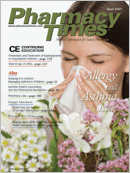Publication
Article
Pharmacy Times
Cheaper Biologics May Soon Be a Reality
Author(s):
The FDA currently has no mechanismor authority to licensegeneric equivalents of brandname large-molecule, protein-basedmedications such as vaccines, insulin,clotting factors, and human growthhormone (HGH). This situation is unlikelyto change soon, because qualifyinga medication as a generic requiresdemonstrating that both products'active pharmaceutical ingredients haveidentical molecular structures and areequally safe and effective. The sciencenow available does not permit a determinationof the first criterion. Consequently,every biologic licensed inthe United States must undergo extensiveclinical testing.
If Congress passes legislation thatwas introduced in mid-February, however,unbranded versions of biologics that(using the bill's language) are "comparable"with brands would be spared therequirement for multiple, lengthy, costlyhuman tests in many instances.1
Several biopharmaceutical productsalready on the US and worldmarkets fall into the "comparable"category. To citejust 2 American examples,the Drugs@FDA Web sitelists 5 licensed standardreleaseversions of recombinanthuman insulin and 10versions of the most widelyused recombinant HGH somatropin.2 In China, wherethe government took a verybroad view of what internationalpatent laws alloweduntil recently, >400 companiesare producing 30 recombinantdrugs, 41 vaccines,and 18 blood products currentlyunder patent in other countries.3
The drug-patent situation and what itmeans for generics will be the subjectof an article in next month's issue.Suffice it to note here that not requiringa full-blown license and approvalprocess for each biologic saved moneyin China and would likely do the samehere. The pharmacy benefit managerExpress Scripts estimatesthat allowing copies ofpatented biotech productsonto the US market wouldproduce savings of $71 billionover 10 years.4
The Legal Status ofBiogenerics
Legally speaking, biogenericsdo not exist. Rather,there are "biosimilars" inEurope and "follow-on biologics"in the United States.In 2005, Sandoz did claimto have received the firsteverFDA license for a biogeneric,when the agency issued a positivedecision on Omnitrope (serotropin[rDNA origin]). According to the drug-maker,its product was the equivalentof Pfizer's Genotropin. The agency explainedthat, because neither the structuralnor the effectual equivalence ofthe 2 products could be adequatelyassessed, Omnitrope was best characterizedas a follow-on product with thesame indication as Genotropin.5
Reaching such a decision, as illustratedabove, was not unique for theagency. The recently introduced Accessto Life-Saving Medicine Act (HR1038) aims to make it more common.
Following the model for licensingsimilar biologic medicinal productsarticulated by the European Agency forthe Evaluation of Medicinal Products(EMEA), the US bill would establish aframework for companies to submitAbbreviated Applications for BiologicProducts (AABP).6,7
AABPs seeking "comparable" statuswith a brand product would have tomeet the criteria outlined in the sidebar.An applicant also could seek "interchangeable"status, but it would haveto clearly demonstrate that its productwas exactly the same in molecularstructure, safety, and efficacy as the referenceproduct. The legislation acknowledgesthat meeting these criteriawould be difficult. A key provision of HR1038 is that it would allow the FDA todemand clinical tests by AABP applicantsif the comparability or interchangeabilityclaimed was not initiallyapparent.
Are Comparable Biologics ReallyAny Different?
The most accurate answer is, "Noone knows yet." Even a summary of HR1038 states, "There is currently noequivalent of a simple ?bioequivalence'study for biologics as there is for traditionaldrugs."1
Additionally, as the BiotechnologyIndustry Organization, which representsbiopharmaceutical manufacturers,explains, "Due to ...differences inhow the product is manufactured, differentversions of the same biotechnologyproduct produced by companiesother than the innovator will inevitablydiffer in certain respects from the innovatorproduct."7 What that means forpractical purposes, according to theEMEA, is that product "parameterssuch as the 3-dimensional structure,the amount of acidobasic variants, orposttranslational modifications such asthe glycosylation profile can be significantlyaltered by changes, which mayinitially be considered to be ?minor'inthe manufacturing process."7
Determining whether any follow-onbiologics are true biogenerics willrequire completely characterizing bothproducts'molecular composition. Thenan assessment of whether nonidenticalmanufacturing processes produceany significant differences in productcharacteristics will be needed. Last, itwill be necessary to determine whetherany dissimilarities between productsare related to clinically meaningful differencesin how the products affectpatients.
Mr. Lamb is a freelance pharmacywriter living in Virginia Beach,Va, andis president of Thorough Cursor Inc.
References
1. Detailed Outline: The Access to Life-Saving Medicine Act. February 14, 2007.Representative Henry Waxman Web site. Available at:www.henrywaxman.house.gov/pdfs/biologicsbillsummary_2.14.07.pdf. AccessedFebruary 20, 2007.
2. Drugs@FDA. Available at: www.accessdata.fda.gov/scripts/cder/drugsatfda. AccessedFebruary 20, 2007.
3. Zhou EY, Langer E. China today: defining the Chinese biopharmaceutical market.BioPharm Intl. 2007;January. Available at:www.biopharminternational.com/biopharm/article/articleDetail.jsp?id=395607. AccessedFebruary 20, 2007.
4. Express Scripts. Generic biotech medicines could save plan sponsors and patients $71billion. Press release. February 15, 2007. Available at: http://phx.corporate-ir.net/phoenix.zhtml?c=69641&p=irol-newsArticle&ID=963453&highlight=Generic%20biotech. AccessedFebruary 20, 2007.
5. US Food and Drug Administration. 2005. Omnitrope (somatropin [rDNA origin)Questions and Answers. Available at:www.fda.gov/cder/drug/infopage/somatropin/qa.htm. Accessed February 21, 2007.
6. Biotechnology Industry Organization. Follow-on Biotechnology Products. Availableat: www.bio.org/healthcare/followon. Accessed February 21, 2007.
7. European Agency for the Evaluation of Medicinal Products. 2005. Guideline onSimilar Biological Medicinal Products. Available at:www.emea.eu.int/pdfs/human/biosimilar/043704en.pdf. Accessed February 21, 2007.







